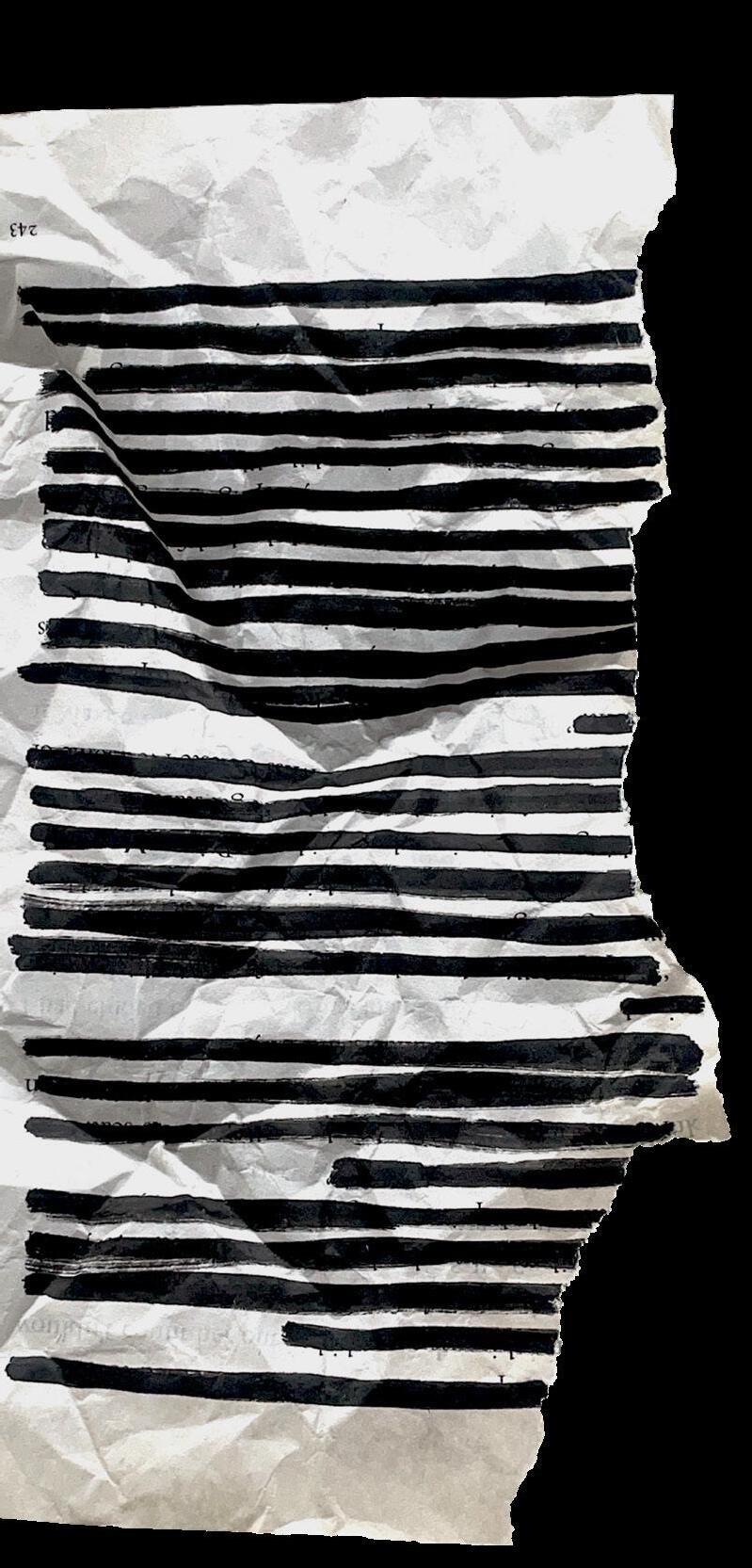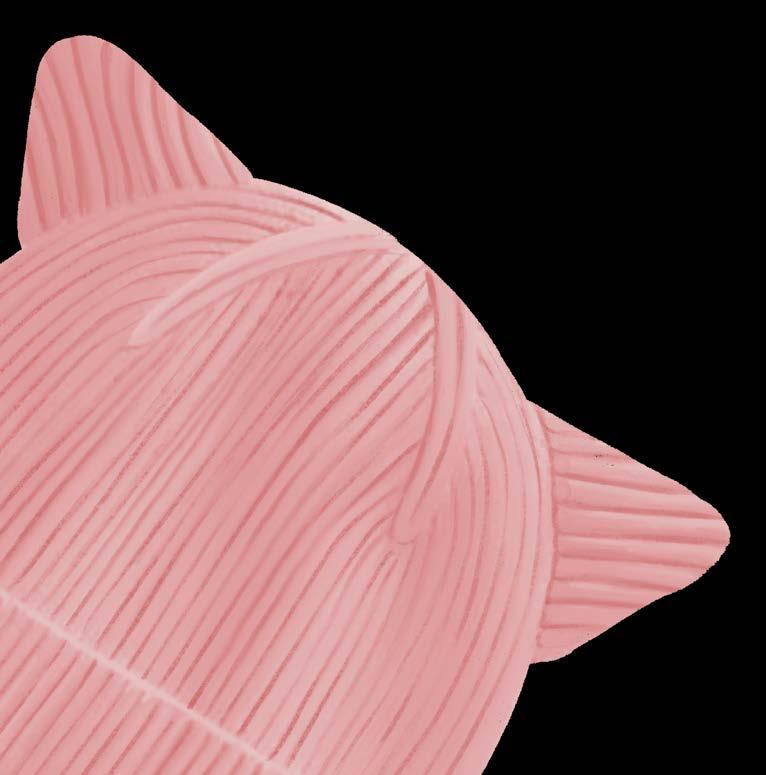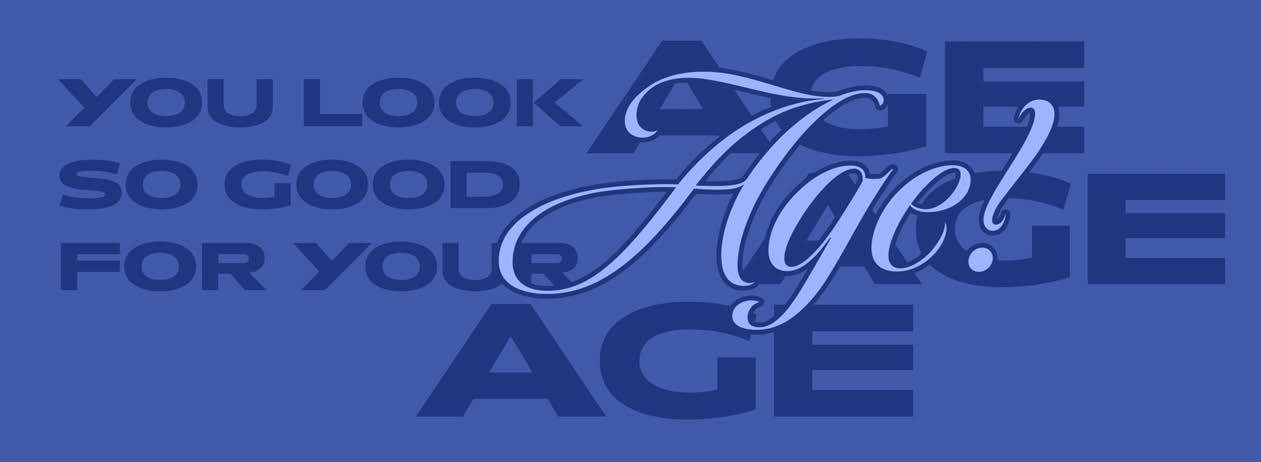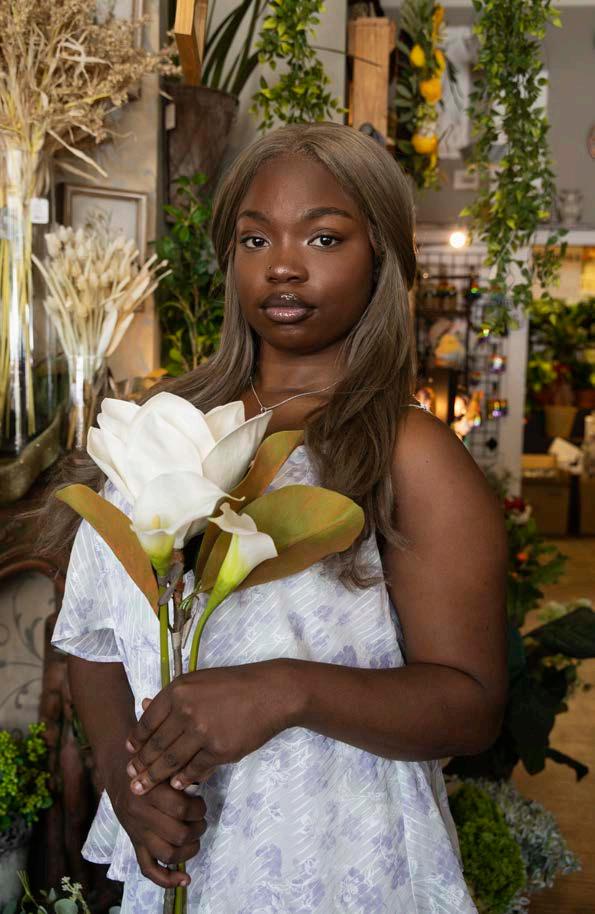
BEHIND THE BEAK
A DEEP DIVE BEHIND CAROLINA’S BELOVED MASCOT
THE FABRIC OF RESISTANCE HOW STUDENTS USE FASHION TO MAKE A POLITICAL STATEMENT
MYTHICAL MUSES
CAPTURING THE ESSENCE OF FOLKLORE IN FASHION
+
A LOOK AT THE RELATIONSHIP STUDENT MAGAZINE OF THE UNIVERSITY OF SOUTH CAROLINA BETWEEN AGING AND ONE’S PERSONAL SENSE OF BEAUTY

OFCOLUMBIA’SSOURCE LITERARYMAGIC. 743hardenstreet| (803)205-4139 monday-Friday 10a.m.-8p.m. saturday9a.m.-8p.m. sunday11a.m.-6p.m. www.allgoodbooks.com
STUDENT MAGAZINE OF THE UNIVERSITY OF SOUTH CAROLINA
EDITOR-IN-CHIEF MANAGING EDITOR
CREATIVE DIRECTOR ENGAGEMENT DIRECTOR
KAYLEN PRITCHARD
RIDHA FATIMA
LEXI CROFT
AWANI BILDIKAR
WRITTEN
ARTICLES EDITORS Ahalya Muraleedharan
Jordan Jeffreys
Gus Varallo
COPY DESK CHIEF Chris LeBarron
ARTICLES WRITERS
Kiersten Alexander, Raeva Bali, Gracie Belk, Aleena Chattha, Laura Anne Kay, Sydney Lewis, Ella Lukowiak, Hannah Magner, Audrey Miller, Stephanie Roznowski, Olivia Schutte
COPY EDITORS
Grace Butler, Francesca Cumello
VISUAL
PHOTO EDITOR Raynee Quillen
ASSISTANT PHOTO EDITORS Laura Lucivero Alyssa Bladzik
ART DIRECTOR Lily Ferguson
ASSISTANT ART DIRECTOR Megan Wooters
MULTIMEDIA DIRECTOR Faith Fulmer
STYLE DIRECTOR
Kylee Strickfaden
PHOTOGRAPHERS
Caitlyn Campbell, Kirsten Clark, Rachel Egeland, Evelyn Esquivel, Hannah Flint, Chelsea Gourdine, Sashi Vyas
DESIGNERS
Alexandra Adler, Caroline Christy, Kathy Do, Chloe Ehlers, Katlin Jeffcoat, Elissa Myers
MULTIMEDIA
Anna Heidel, Zane Heinlein, Shireen Kaur
STYLISTS
Benjamin Early, Catherine Levy, Lily Miller, Camille Molten, Tammy Nguyen, Rezzie Omoigui
GARNET & BLACK | 3
SOCIAL MEDIA DIRECTORS
ENGAGEMENT
Zamiyah Johnson
Amelia Codillo
PUBLIC RELATIONS DIRECTOR
Imani Polly
SOCIAL MEDIA MANAGER
Madison Thompson
PUBLIC RELATIONS MANAGERS
Tamaria Dawkins, Laine Gray, Carly Kisselle, Stella Tew
GARNET MEDIA GROUP
AD SALES TEAM
Kylie Kurinsky, Kate Levey, Abigail Romani, Sofia Sabatino, Marisa Tartamella
CREATIVE SERVICES
Chloe Ehlers, Lily Ferguson, Savannah Nagy, David Olsen
Advertising: (803) 777-3018
To contact G&B, email sagandbe@mailbox.sc.edu or visit www.gandbmagazine. com. Garnet & Black Magazine is printed twice a year by students of the University of South Carolina and is distributed for free to members of the university community. All editors can be reached via email on our website. The office is located in Russell House University Union Room 339.
DIRECTOR OF STUDENT MEDIA
ASSISTANT DIRECTOR OF STUDENT MEDIA
ART DIRECTOR OF STUDENT MEDIA
ADVERTISING ADVISOR
FACULTY ADVISOR
Sarah Scarborough
Sydney Cranmer
Krista Larson
John Burbage
Scott Farrand
SPECIAL THANKS
Jason Porter
4 | GARNET & BLACK
COVER PHOTO ALYSSA BLADZIK DESIGN LEXI CROFT MODEL JOHN BURBAGE, GARNET MEDIA GROUP AFFILIATE
A deep dive into Carolina’s beloved mascot.
A local band’s journey from a dorm room to one of Columbia’s biggest stages.
How the digital world tricks us into fearing the aging process.
A creative piece based on the love stories immortalized on campus sidewalks.
How misunderstanding mental illness can have devastating effects.
An original poem by Ella Lukowiak.
Farmers Market XChange brings fresh produce to the concrete jungle.
The haunted heart of Columbia.
How classical philosophy can be applied to today’s tumultous times.
Capturing the essence of folklore in fashion.
Despite strides in diversity, the threat of book banning is alive and well.
The power of a podcast in amplifying refugee stories.
The story of South Carolina’s vibrant Gullah Geechee community.
An original poem by Raeva Bali.
How students use fashion to make a political statement.
A short story by Jordan Jeffreys.
A look at the relationship between aging and one’s personal sense of beauty.
Florals? For spring? Groundbreaking...
OF CONTENTS 7 39 10 44 13 46 16 49 18 54 21 60 26 64 31 66 36 70 BEHIND THE BEAK FROM CAPSTONE TO COCKSTOCK MODERN LOVE AT USC LET’S TALK THERAPY TALK
COLLECTOR
IF MY
THE FABRIC
RESISTANCE
GROWING
TABLE
ROOTED IN CYPRUS
LEGENDS AND LORE THE INTRICACIES OF STOIC THOUGHT MYTHICAL MUSES OPEN MINDS, EMPTY SHELVES PASSING THE MIC HELP ME TO HELP YOU TO HELP US
MOTHER NEVER LEFT
OF
THERE ARE MONSTERS IN THE CLOSET LOOKING AT LOOKING GOOD FOR YOUR AGE THE GIFT OF
OLDER LANGUAGE OF FLOWERS
GARNET & BLACK | 5
LETTER FROM THE EDITOR F
 AUTHOR KAYLEN PRITCHARD PHOTO LEXI CROFT DESIGN LEXI CROFT
AUTHOR KAYLEN PRITCHARD PHOTO LEXI CROFT DESIGN LEXI CROFT
For as long as I can remember, I’ve been obsessed with stories. Whether I’m telling them or consuming them, it’s what makes me tick. I’m absolutely the kind of person to talk your ear off about whatever book I’m reading or ask you to watch the first few episodes of my favorite show, which I’m sharing with you as an “act of love.” And for you, dear reader, I have poured all the love I have into this issue of Garnet & Black, which has been such a gift in my life as a committed storyteller.
My personal story this semester certainly did not go as I planned. I never expected to be editor-in-chief, and it’s been a challenge adapting to a new normal so quickly. I knew that my lovely, brilliant staff and our beloved readers were counting on me to maintain the same passion and fortitude as my predecessors. As we’ve established, passion for bringing stories to the world is quite frankly the cornerstone of who I am. You can imagine my gratitude to this magazine for giving me a place to bring that excitement to fruition. It’s more than I can put into words.

For this edition, we wanted to capture the role that origin plays in what a person will become. We are all works in progress, and each aspect of our identity and our path culminate in our ultimate masterpiece—ourselves. I believe that nothing is wasted as long as you allow it to help shape you into the happiest and most fulfilled version of yourself. Material success is certainly wonderful, but my wish is that we all take more time to search for beauty in unassuming places. You can lose everything you own in an instant, but the treasures of knowledge and experience that live in your heart will follow you forever.
Within these pages, you’ll find stories of all kinds, be they history and folklore, social justice, or feature spotlights on the people who make our community so vibrant. You’ll read tales of love, homeland and resilience… but sometimes, our stories don’t always go the way we plan, no matter how fervently we try to take hold of the pen crafting our journey. Hardship is inevitable, and the triumph that springs therefrom is what becomes an epic tale worth immortalizing. If you are the sculptor, your past holds your tools, and you are your magnum opus. As always, thank you for reading Garnet & Black.

With all the gratitude in the world,
6 | GARNET & BLACK
BEHIND THE BEAK
Whether you’re a student, professor, alumni or fan, if you’re involved with the University of South Carolina, you’re bound to know who Cocky is. But do you really know him? Who is our beloved mascot, how did he come to be and what does he mean to our community today?
Before Cocky, there was Sir Big Spur, or “The Rooster,” but before that, USC was only known as the “Gamecocks.” Where did the idea of a fighting rooster even come from? It all started with Gen. Thomas Sumter, an American Revolutionary War general who was known as “The Fighting Gamecock” due to his fighting and military tactics during the war. The Cocky that USC fans know and love today made his debut on Oct. 18, 1980, almost 45 years ago, at the homecoming game against Cincinnati.
John Nelson, an undergraduate student, was already in the race for USC’s mascot at the time. He created




AUTHOR
Who is Cocky, Carolina’s most beloved mascot?
GARNET & BLACK | 7
management and retail management, with a minor in entertainment management, on top of all her secret responsibilities as our beloved mascot.
Parker reminisced on her time as Cocky with a reverence one might have for a high school sweetheart. Parker had always loved characters like Cocky. Even as a kid, she said she “always gravitated towards mascots.”
The anonymity of the role also
out end up at the audition.”
She emailed the head cheerleading coach at the time and started the audition process. At the time when she joined, the audition consisted of a 30-second skit, an improv section and an in-person interview. Parker remembers her own audition, when they gave her a cone and a car windshield shade to work with, a trick combo that she somehow made
be anyone. He’s a representation of everything we could be, and everything we want to be.
Some of Parker’s favorite memories as Cocky come from the Cocky’s Reading Express program, which she was the first female lead for. The program works to serve children from grades pre-K through second grade in Title I elementary schools in South Carolina. They make visits frequently,





with sports.” Parker continued her involvement with sports teams and community long after graduation. She currently works in hospitality but has previously worked for the Tampa Bay Buccaneers as well as the San Antonio
than a mascot. He is a reminder to unleash your inner child-like joy and to be whatever you want to be. While his main job involves pumping up crowds and cheering on our athletic teams, he serves a greater purpose for our bird suit.
In her words, Cocky taught her to “dream big and to celebrate everything.” Her advice to any future Cocky’s is to just “go for it. Especially if you are a not a cisgender male, I think it’s so



GARNET & BLACK | 9







The Third Floor’s journey from tracking songs in a dorm room to opening at one of Columbia’s biggest stages.
Music can be the heart and soul of a community, and in special cases, the heart and soul of a college dorm. The Third Floor is a student band that has its roots in Capstone House on campus. Humble beginnings to be sure, but a fateful meeting on the third floor of the building would define the Columbia student music scene. The story of playing on the floors of







Capstone to opening for COIN consists of a yearslong journey and hours of rehearsals that ultimately brought vocalist and guitarist Ryan Pellatt, bassist Neal Goldberg, lead guitarist Carter Vogt, and drummer and vocalist Nick Guzman to the mighty stage of Cockstock.
a pretty classic blues track, and it’s a blast to play,” said Pellatt. “We’ll get people dancing because it’s the blues. You can’t go wrong with the blues.”
“We started playing on the third floor of Capstone,” said Goldberg. “We all lived on the third floor there— hence the name—our freshman
The road from the dorm room to playing gigs is one that Pellatt says requires “a lot of cold calling and a lot of emailing and reaching out to people.” In February 2022, The Third Floor secured their first public performance.

It wasn’t long before the would-be band found its footing in, of all places, a dorm room. “The first night that we met, which was the first night at the dorms, we went to [Guzman’s] room and he had his studio set up,” said Pellatt. “We started tracking songs and messing around with music, and it started to form from there.”
Pellatt cites Noah Kahan and John Mayer as two of his musical influences, and Goldberg credits The Beatles, Mt. Joy and The Stews. All of these sounds culminate in what Pellatt describes as “indie blues folk rock.” “‘Marlboro Blues’ is our most popular song on Spotify right now because it’s our most recent release, but it’s


“Our first real gig was Southern Belly Barbecue, which does not exist anymore,” said Goldberg.
“We used to go down there freshman year and somehow convinced [the owner] to let us set up a DIY show there, and we put posters up all over Columbia and campus.”
Of course, with every great show comes days and days of prep work. “We knew only four songs at that point, so we worked ourselves every single day,” said Pellatt. “We were probably practicing for a few hours [a day] at least, learning new songs and we got ourselves up to a twelvesong setlist.” This first gig was a success, a big step for the budding band. “It was awesome. A ton of our friends showed up, and it was a really, really great time,” said Pellatt.
Playing for your peers in a quaint, hometown setting has its own kind of magic. But in Fall 2023, The Third Floor set its sights on their largest venue yet: Cockstock.
“The committee putting it together reached out to the School
AUTHOR KAYLEN PRITCHARD PHOTO LEXI CROFT DESIGN MEGAN WOOTERS
10 | GARNET & BLACK






bands that he thought would be willing, and [Professor Polley] gave our name along with some other bands,” said Pellatt. “It was between three and four [bands], and we were fortunate enough to get that gig.”
Beneath blinding lights and harmonized by an enthusiastic crowd, The Third Floor took the stage to open for COIN, a pop-rock band that has amassed over 3 million listeners on Spotify. It’s no small feat to land a gig at all, let alone one of this caliber.
“We can estimate maybe 400 or 500 people there, all our peers, our fellow student body. It was the coolest thing ever. Everyone had incredible energy, was paying attention, was listening to our original music, and we had never had the chance to put out our music to that many people who are eager to listen,” said Pellatt. “It was the best feeling ever.”






For many student bands, playing at a venue like Cockstock is a pipe dream. For The Third Floor, years of effort culminated in making this larger-than-life experience a reality. Pellatt and Goldberg both reminisce on the performance with deep gratitude and fondness.
“I’m so grateful to be able to have the opportunity to do something like that. I can hope we get back to the point where we can play another show like that, but you never know. That was something I was soaking in while this was happening,” said Goldberg. “It was an incredible once-in-a-lifetime experience.”

few months prior to Cockstock, The Third Floor was asked by a fraternity to open for their festival.
“We were super excited, and we got there around 2 o’clock for a sound check. Our spot was between 5:45 to 6:45 on a Friday, so pretty early. But we see this massive field... and it was the biggest stage we had played yet,” Pellatt said.
Sometimes, the size of the venue doesn’t equal a more enjoyable performance. In fact, Pellatt and Goldberg insist that as long as there’s music being played, there’s fulfillment to be had. Last spring, a
After prepping for a rousing performance, the band noticed that the venue had not filled up at all. The crowd stayed extremely minimal even as The Third Floor took the stage. “We played our whole set to my girlfriend, Nick’s







girlfriend, our roommate and three of the guys from the band playing after us,” said Pellatt. “It was hilarious.”
Despite the small audience, the band was not at all deterred in their excitement to put on a great performance. “We were going as hard as we could,” said Pellatt. “I was laying on the ground playing at times. That experience would go to show that it doesn’t matter who you’re playing for, you’re still playing music, and it’s fun.”






advantage of that mindset. It’s the best thing to do in the world, but it’s still a lot of work, and I know that people who are interested in it are so dedicated, and that’s why it is so fun to do. At the end of the day, keep drilling at it until you’re satisfied with it. If you’re like most musicians, that will be forever,” said Pellatt. “Allow your passion to drive you, and try to make your mark.”
As an artist, it can be easy to get wrapped up in the desire to commercialize your work, but Goldberg implores budding musicians to keep one piece of advice in mind: “Make sure that having fun playing music is always the first priority over money or business or anything else.”
On May 10, Pellatt and Vogt will be playing at Curiosity Coffee along with the band North by North. Be there or be square. You can follow The Third Floor on Instagram at @thethirdfloorband and on Spotify.
Pellatt echoes this sentiment, urging artists to never stop honing their craft. “Don’t let venues and establishments take







Let’s Talk Therapy Talk
Buzzwords and phrases are setting mental health advocacy back; how can college students stop contributing to the problem?
AUTHOR BROOKLYN BROWN PHOTO CAITLYN CAMPBELL DESIGN MEGAN WOOTERS
This article contains mentions of suicidal ideation.
Today was a rough day. Studying for that exam made you literally want to kill yourself. You have total PTSD from failing the last one. The cherry on top of all of the stress is that when you get back to your dorm, your room is a mess—you’re so OCD about keeping it clean, but your roommate is much less organized.
Wait… let’s backtrack. Yes, today was a rough day, and studying for that exam was tough, but you’ve never genuinely been suicidal in your life. You’re feeling nervous about this test because you failed the last one, but nervousness hardly fits the criteria for Post Traumatic Stress Disorder. And what does OCD really stand for anyway? Stopping to think about the weight of your words can take practice, but it’s far more important than you might realize.
Khushi Dave is the vice president of USC’s mental health and wellness organization Active Minds. As
someone who has struggled with her own mental health, Dave feels that ignorant therapy talk can feel, “really invalidating to people, especially when it is reduced down to a common experience.” Without realizing it, many people exaggerate their feelings when they are actually only experiencing a normal phenomenon.
“People are prone to hyperbolizing when they feel strong emotions, and oftentimes it comes out as quantifying it as a mental illness,” Dave said. “There are so many other symptoms, and there are so many other factors that go into diagnosing things.”
These types of hyperboles can be classified as “therapy talk” among students.
Dr. MiKi Kitchen, a senior instructor at USC in the psychology department, uses the following analogy when discussing the misuse of therapy talk:
“A lot of us feel blue… and we still go on about our day,” Kitchen said. “An individual who has actual depression that is diagnosable, they are not able to function unless they put the parameters in place.”
Based on experiences with students and clients, Kitchen recognizes that individuals who live with a mental disorder would give anything to feel a sense of normalcy in their

life, while people who sensationalize mental health issues often use it as a crutch.
“As someone who works with veterans and trauma survivors, they wouldn’t want to wish this on anybody else,” Kitchen said. “They would change their life in a heartbeat and it’s not something that’s a fad nor should be normalized to that level.”
These “parameters” that Kitchen mentioned, can be found through proper diagnosis and treatment; with medicine, therapy and improved life structure, people with debilitating mental disorders can begin to function at a healthier level. According to The National Alliance on Mental Illness California, modern treatments for mental health disorders are very successful; with a combination of pharmacological and psychosocial treatments, 70 to 90 percent of patients see their symptoms significantly reduced and experience an improved quality of life. However, the spread of misinformation about mental illness through stigmatized dialogue can prevent people from seeking the help that they need.
“If you are surrounded by a friend group and if anything bad happens to them, they kind of just jokingly talk about being depressed or having really
Alack of understanding can
GARNET & BLACK | 13
l e a d t eh eritne itsongaid c p rocesstobe se n sationalizedratherthan normalized.
bad anxiety; oftentimes, it can make you feel like, ‘Oh, this is normal,’” Dave said.
Applying mental illnesses to everyday experiences can become invalidating to those in actual mental health crises.
“Unfortunately, it then diminishes those who do actually have [a mental disorder] and they don’t seek help,” Kitchen said. “They question themselves, they question the process, they question all of that.”
A lack of understanding can lead the entire diagnostic process to be sensationalized rather than normalized. In reality, there is nothing sensational about mental illness. Dave uses OCD as an example of a common misconception.
“It is the most common [diagnosis] that is misunderstood in terms of what it actually is,” Dave said. “Keeping things tidy, that’s not at all what it is… it’s actually this really debilitating life disorder that prevents you from doing a lot of things that you want to do.”
Obsessive-Compulsive Disorder, or OCD, has two parts, according to Rodgers Behavioral Health. First, the disorder involves obsessions, or unwanted thoughts, images and urges. Obsessions can cause high levels of anxiety which individuals with OCD try to neutralize by performing compulsions. Compulsions are the second part of the disorder and can include behaviors such as washing, checking, organizing or a mental act.
OCD goes far beyond “keeping things tidy,” and its gravity is widely
misunderstood just like many other mental health disorders.
come to class and I know based on disability reports and whatnot that they have anxiety that is crippling, but yet they still show up,” Kitchen said.
mental health struggles; according to the World Health Organization, 4 out of 10 leading causes of disabilities in the United States and other developed countries are mental health disorders. In 2020, Major Depressive illness became the leading cause of disability in the world for women and children.
Talking about mental health is not harmful if it is done in a way that reduces misconceptions rather than diminishes genuine struggles. Kitchen is happy with how society as a

Peo p l e are f ar fromalonein
ac c htlaeHdlroWehtotgnidro O r g a ni
o u n
their mental healthstruggles;
zation , 4outof10 leadingcausesofdisabilities in the UnitedStates and other developed c
redrosidhtlaehlatnemeraseirt
14 | GARNET & BLACK
whole has begun to talk more about mental health-related issues, but she fears that it may be heading to a dangerous extreme.
“We are doing a really good job of normalizing it and reducing the stigmas, but in doing so, we have swung so far to the other side of things that it is becoming a fad.” Kitchen said.
If this fad discourages individuals with mental illnesses from taking their emotional health seriously, the effects of their untreated disorders can be detrimental to themselves and society as a whole. According to the NAMI California, untreated mental health conditions can result in consequences such as unnecessary disability, unemployment, substance abuse, homelessness, inappropriate incarceration, suicide and poor quality of life. These staggering effects bleed into the economy, costing the United States more than 100 billion dollars each year.
Destigmatizing mental healthrelated issues takes more than just conversation; it takes educated dialogue to properly confront the problem.
“I think it’s a matter of education,” Kitchen said. “I do take it very seriously. I talk about it in the class that I teach.”
Even if you might feel like a buzzkill killing the buzzwords, confronting and educating your peers is necessary to address when people around you misuse therapy talk in unhealthy ways.
“I think that just overall it can be kind of hard to address it when it is so prevalent and a lot of times you don’t even realize that you’re talking about it,” Dave said.
Dave believes that the first step to tackling this issue is to be mindful of your own words and to think about the impact you’re trying to make with what you say.
“There are a lot of other strong emotional words that portray how you are feeling without undermining the way other people are living their lives,” Dave said.

Accordingto
Il l ssen
n rt e a t me n t s f or
successfu l; w i t h a c o bm i itanno o f hp a r am c o l o ig c la a n d p sy c hosocialtreatments,
to m s isgfindecuderyltnac ecneirepxedna
n i
GARNET & BLACK | 15
Te NationalAlliance on Mental
,ainrofilaC redom
mentalhealth disordersarevery
70 to 90 percentofpatientsseetheirsymp
a
m provedquality of life.
collector
an original poem
AUTHOR ELLA LUKOWIAK DESIGN ALEXANDRA ADLER

if i close my eyes maybe i’ll remember everything i shoved under my floorboards after you told me that i think too much i didn’t know what to say to that except that the tendrils of steam from my morning coffee are wrapping around the sunbeams tie-dying our kitchen table flamingo-pink, and sunday mornings smell like laundry and a thousand i love you’s picked up off the floor from where i last let them roam free and collect dust; i have to run them on delicate to make out the grooves and capture the feeling of the woman in the army-green coat who held her daughter’s tiny palm and whispered those three words

i am a collector
i have loose change and loose teeth and loose dreams i still beg to fall from the sky like the stars sometimes did when i was young and the window was a pedestal for my hope to dance on
i have armfuls of chocolates and bottled air that smells like the sea; i have been told that i think too much, but i’d rather dance around a shattered heart than trudge through the mud with blinders on to avoid pricking tender skin on the truth
my floors are coated in letters, trace them like a map until you find the word you have been looking for
16 | GARNET & BLACK

financial support provided to me during my internship proved to be greatly enhancing my overall experience… These provisionssignificantly contributed a more holistic rewarding internship experience.
Randale Pete Computer Engineering
$3,000 The University of South Carolina is offering supplements for qualified students who work internships and co-ops in Summer 2024 that support high-demand industries in the State of South Carolina. APPLY TODAY!

The deadline to apply is June 14, 2024!
803.777.7280
VISIT ONE OF OUR FOUR LOCATIONS University Career Center (Thomas Cooper Library, Level 5) College of Engineering & Computing (Swearingen, 1A03) Graduate Student Resources Hub (Close-Hipp, 204) Pre-Professional & Graduate School Advising (Sumwalt, 208) CONNECT WITH US ONLINE sc.edu/career facebook.com/UofSCcareers instagram.com/uofsccareers
OR
 AUTHOR SIMONE MEYER DESIGN KATHY DO
AUTHOR SIMONE MEYER DESIGN KATHY DO

“NOWHERE YOU CAN GO is more peaceful—more free of interruptions— than your own soul.”
This message could belong to any number of self-help books. You could find it in the teachings of a popular influencer or public figure. You may not, however, expect to find the quote written in the meditations of a king and war general nearly 2,000 years ago.
When Ancient Roman Emperor Marcus Aurelius jotted down his thoughts in a journal in the early 170s CE, it is doubtful he would have realized
the scope his philosophy would grow to influence individuals living in the 21st century. His writings have been archived, among those of Seneca and Epictetus, to comprise the early works of Stoic thought—a philosophy that emphasizes mental fortitude.
According to Andrew Berns, University of South Carolina associate professor of history, Stoicism is a philosophical doctrine that arose in classical antiquity. It stresses selfreliance and
urging people to accept what
gives them without lamenting or combatting that fate.
Berns explained that with the onslaught of negative messages from the media, Stoicism can be a useful way to find acceptance.
“The world is really upsetting from transphobia to climate change to genocide to war to Elon Musk,” he said. “And I think that people’s reaction to that is understandably very panicked and tense, and Stoicism gives you tools to find that peace and equanimity in a stormy world.”
non-reactivity,
the universe
18 | GARNET & BLACK
How classical philosophy can be applied to today’s tumultous times.
A study conducted by Springer Nature explored that same idea of stress management. The study found that Stoic training reduced ruminating thoughts and anxiety.
Susan Burbage, a counselor at Rosewood Elementary School in Columbia, SC, corroborates this notion. In social emotional learning classes, Burbage teaches self-regulation that aligns with the Stoic teachings of mind over matter.
“I think it definitely increases your personal emotional well-being and helps with anxiety and worrying about things to be able to calm your emotions and practice mindfulness,” Burbage said.
For classical thinkers like Marcus
nothing can hurt you. He tried to explain his philosophy to his son, Hiccup, who didn’t embody what Stoick considered the proper amount of strength, both physical and mental.
“When I was a boy, my father told me to bang my head against a rock, and I did it,” Stoick said. “I thought it was crazy, but I didn’t question him. And do you know what happened? That rock split in two.”

characters such as Stoick the Vast from “How to Train Your Dragon” or even Sherlock Holmes.
Stoick the Vast expresses a modern interpretation of Stoicism: be tough and

structural organization—whether it be a regime in Ancient Rome or a university in South Carolina.
“Stoicism is trying to control that molecular chaos.”
On the other hand, characters like detective Sherlock Holmes embody a different aspect of Stoicism: mindful observation without judgment. Holmes is strictly analytical, and even as the stakes of the case become heightened, the detective remains objective and unemotional, allowing him to solve mystery after mystery.
Holmes’ tendency to value rationality over emotion, however, creates an extreme case of uncaring.
“Love is an emotional thing,” Holmes said in the novel “The Sign of Four” by Arthur Conan Doyle. “And whatever is emotional is opposed to that true cold reason which I place above all things.”
While these extremes lend themselves well to creating characters in the media, two-dimensional interpretations of Stoicism reduce this nuanced philosophy into cold calculation and stubbornness.
No matter how stoic the individual, it is impossible to be eternally in charge of one’s emotions.
“Reason has its limits,” Berns said. “Fundamentally, to me, feelings lie beneath reason, in the archeology of our brains and souls.”
Marcus Aurelius describes emotions with the metaphor of a chariot being pulled in all directions by a group of wild horses who are corralled by reason, which holds the reins. In this metaphor, emotions and impulses are portrayed as dangerous and volatile if left unchecked.
This internal chaos creates the perfect breeding ground for Stoicism. According to Berns, Marcus Aurelius’s Stoic philosophy branched from an understanding that political instability lurks beneath the surface of every
“I think [there] was also an awareness that life sucks sometimes, and soldiers die, and wives die, and friends betray you, and provinces rebel,” Berns said. “I think awareness of that disconnect between the smoothness of appearances on the one hand and the fragmentation underlying them is one of the things that generates Stoic thought.”
On the other hand, freshman Gabrielle Dissinger believes a Stoic’s desire to control all emotional responses can result in negative outcomes.
“In a way, Stoicism is trying to control that molecular chaos,” Dissinger said. “But it’s improbable to be able to completely ignore the responses that your brain is sending your body if you’re stressed.”
Additionally, Dissinger finds the doctrine that every life event is fated troubling. She believes that feeling no control over external events could encourage passivity in the face of resistance.
“If you believe that every event was meant to happen, then you could be less inclined to take an approach to try to change what had happened,” Dissinger said. “Even if you could.”
However, Burbage expressed that in responding to distressing events, Stoic practices of moderation may be the healthiest coping strategy. Burbage stresses this lesson to her students so that they can make rational, healthy choices in the face of distress.
“There are going to be kids around them and certain situations that happen that overwhelm them and make them feel some hard emotions of anger and sadness and hurtful feelings,” Burbage said. “And what can you do to calm yourself so that you show it or display it in an appropriate way?”
While today’s average citizen is further away from the devastation of war than Marcus Aurelius was, there are still situations of acute emotional
GARNET & BLACK | 19
distress. According to USA Facts, there have been 783 school shootings of elementary and secondary schools resulting in death or injury in the US since 2000. These tragedies devastate communities, leaving friends and families irrevocably changed
Dissinger expressed that for mourners of shooting victims, stoic ideals would do nothing to soften the blow to the community.
“If someone was like, those school shootings are meant to happen, I would
be extremely emotionally distressed,” Dissinger said. “I don’t want that to be fate. I don’t want that to be destiny.”
The idea of destiny makes its way into many aspects of philosophical thought such as fatalism and faiths such as various sects of Christianity. What sets Stoicism apart from these ideologies is that it makes no promises of a future, only peace of mind.
explains that

peace of mind is important for in every aspect and for every walk of life. The skills she teaches her students travel beyond the walls of the classroom and the child development: lessons in Stoicism can be beneficial anywhere.
“Learning those skills is important in just about everything you do as far as functioning in the world with others and with yourself,” Burbage said.


Pay attention to your body and emotional responses and limit use if you have mental health concerns.



OPEN MINDS EMPTY SHELVES
Diversity in books is growing, but the threat of the book banning boom lingers just behind it.








GARNET & BLACK | 21

these bans do the opposite—that they inhibit the children and their ability to learn.
This rise in book banning comes during an age of increased diversity not just on the shelves but behind the keyboard too. Books, especially for children and young adults, are getting more diverse, telling and sharing unique stories and experiences from marginalized groups. This sudden push to keep these books off the classroom shelves is being called into question.
According to PEN America, there were 3,362 cases of book bans across the 2022-2023 school year. This is
The organization separates the types of book banning into four classifications: “banned pending investigation,” “banned from libraries and classrooms,” “banned from libraries” and “banned from
The majority of recorded book bans this school year, 44 percent, fall under “banned pending investigation,” meaning they’re pulled off shelves and their content is reviewed. These books have either been checked and returned to the library or still await review. Even if they are returned, there are many instances where reviews take multiple months, keeping these titles away from students.
books targeted by these bans include characters of color or discussions of race and queer themes. PEN America also found that books that focus on or mention physical abuse, health and well-being, and death have also become primary targets this year, a push they attribute to the extensive outcry of “age-inappropriate” content in schools.
According to the Cooperative Children’s Book Center, of the 3,451 published books the organization received this year, 40 percent had at least one creator of color, and 46 percent had meaningful representation of characters of color or included realworld events focused on different cultures and backgrounds. Additionally, 39 percent of the reviewed material had a main character of color or a nonfiction work revolving around a person of color.

Of the recorded book bans this school year, 38 percent of them fall under “banned from classrooms and libraries,” with 1,263 instances of a complete book ban from a school library and individual classrooms. This is a dramatic increase from the 333 instances in the previous school year.
These book bans are born from a variety of factors, and most of them are pushed by public pressure from national advocacy groups or individuals affiliated with those groups. This, paired with bills passed in state legislatures such as the “Don’t Say Gay” bills in Florida, which banned or restricted discussions of sexual orientation and gender identity in specific grade levels, led to the sudden spike of book bans we see today. PEN America calls this fight against books the “Ed Scare,” where fear of public education pushes people to advocate for the restriction of certain topics from school discussions. Most of these topics include race, sexuality and gender.
The number of books reviewed by the CCBC was about the same as the number of book ban cases for the 2022-2023 academic year. Of the books banned, 30 percent of them included characters of color or discuss race and racism, and another 30 percent included queer characters and themes.


It’s not surprising that many of the
These bans are acting under the guise of helping children when in reality they only harm them . Books, both fictional and nonfictional, are learning tools for people of all ages—they take us into a world different from our own, introduce us to people different from ourselves and show us problems we’ve never had to experience. It gives a new perspective, and taking away that perspective only leaves a person unaware. Sharing diverse stories allows different people to understand one
another, to explore other possibilities. Restricting these stories from public schools is the complete opposite of what they’re meant for.
There has been a lot of public outcry regarding this recent push for banned books. In September 2023, Scholastic announced a plan that would help schools subjected to book bans by putting books relating to race, sexuality and gender in a separate collection called “Share Every Story, Celebrate Every Voice.” This way, schools could decide whether or not to order that specific display. The publishing firm immediately received backlash for their decision; National Public Radio cited a post by Amanda Gorman, a poet whose book was also put in the collection. Those against the plan argue that these books are necessary now more than ever—separating and isolating the voices of marginalized groups does more harm than good.
On February 12, 2024, the State Board of Education approved of regulation 43-170, which gave the board control over book reviews in South Carolina schools. Rosie Booker, a senior at USC and a member of the school’s American Civil Liberties Union chapter attended the board meeting against the implementation of the amendment.
“Primarily, we were there to raise awareness on this side of the teachers and librarians that we believe that they have the agency to decide what books are appropriate for children,” Booker said. The ACLU also wanted to remind the school board of the recent nationwide push to ban books and educational material from school systems, especially books that focus on more diverse identities and content.
“These book bans aren’t existing in a bubble or for any real moral judgment,” Booker stated. “It’s simply to silence minority voices.”
Booker mentioned how a lot of the conversation during the hearing revolved around what’s considered “Age and Developmentally Appropriate” according to the board and to concerned community members. Booker believes this fear of explicit content in schools will be abused by those pushing for these book bans, and she details a specific example from the hearing. An anti-regulation speaker brought a book on the ban list in front of the board and read it in its entirety—it was completely kid-friendly and was only marked explicit due to a reference to same-sex couples.
“This is largely due to a greater issue that’s kind of happening in the courts right now, that they’re trying to sexualize the existence of gay people,” Booker explained. Booker went on to explain how this push to sexualize queer relationships is the reason why any media featuring a queer person may be labeled as age-inappropriate and explicit.
Booker believes that due to this fearmongering, middle schoolers and high schoolers will be affected the most. She discusses some of the books being banned under “Age and Developmentally Appropriate” where abuse and rape have literary relevance. In books with literary merit, these themes have a purpose, one meant to teach a lesson or share a story. Booker explains how a lack of exposure to these topics in literature could lead to students being unaware if they’re experiencing them in real life.
Diversity Awareness Youth Literary
of violence at home and not be able to read about it?’ And I thought that was just so impactful,” Booker said.
Booker also highlighted how Gen Z is the generation with the lowest teen pregnancy and teenage intimacy rate thanks to major pushes for sex education. Now that we’re starting to draw back on these resources, there are bound to be consequences.
But the key word in this discussion surrounding sexually explicit material is “children,” one that was thrown around constantly during the hearing. Booker emphasized how there are no books with depictions of sex in elementary school libraries or a puberty book in a kindergarten classroom. But when people put the word “children” and “sexually explicit” in the same sentence, it will cause an uproar. “I think that’s a really purposeful hyperbolism of what’s actually happening to discredit librarians and teachers and make them seem like they don’t know what they’re doing or that they have a purposeful agenda to taint the youth,”





also an attack on diverse voices. Booker explained how a lot of the meeting was dominated by what’s considered age-inappropriate, and how people glossed over how many books on racial injustice were at risk. South Carolina has a rich, diverse population, and it’s important that this is reflected in the literature its schools teach. “I think trying to erase that history and hiding those books about minority identities and covering up that whole aspect of it is so dangerous,” Booker shared.
That’s not to say all parts of the regulation were cause for concern.
During the hearing, a few amendments were added to the fourth clause of the regulation, stating that only parents and legal guardians can file for a book to be reviewed, and they can only submit five complaints each calendar month.
Before this added amendment, there wasn’t a rule stating who could and could not file a book complaint. This allowed one woman to submit 572 books for review in Dorchester School District 2 in South Carolina. Due to the broadness of the former guidelines, she
was able to submit these complaints even though she did not have a child who attended school in that district. Additionally, only 160 books were actually present in the school district. So far, this has been the state’s largest mass book ban attempt.
Parents play a vital role in school systems. It’s important that their voices aren’t drowned out by those from the outside. “I think that there is nothing wrong with parents and guardians having an active say in what books are at their children’s disposal,” Booker explained. “I think that parents trust these districts a lot more than these outside entities who are actually pushing an agenda.”
The board also added another amendment: a book that’s filed for complaint does not automatically go to the board. Instead, the parent would have to meet with either the teacher or a representative from the district where the book is available. Booker believes this method is an improvement from the book’s fate being solely in the hands of the school board. “Teachers and librarians know what they’re doing,” Booker stated. “They know
what’s appropriate for children.”
While there are some good amendments added to the regulation, it doesn’t tackle the root problem. This regulation—and many others like it nationwide—is a result of a massive push to keep students from having access to more diverse and eye-opening material. This isn’t an issue that can be ignored, not when it’s finding its way into our courts and legislation.
With this influx of restricted literature both nation- and state-wide, some professors at USC are bringing the discussion to their classrooms. Such is the case with Anne-Laurie Sabathier, a PhD student and graduate teaching assistant in the English department. Sabathier teaches a Capstone introductory English course focusing on queer literature. She decided to teach banned books in her class, hoping that her students could make their own opinions on why they were banned rather than a state legislature doing it for them. Sabathier explained the importance of uplifting these banned books where they’re accessible.




Discussing these books is only one step forward in the fight against book bans; it also takes some personal reflection and self-evaluation. People need to think about why books are banned, what factors come into play and whether or not the ban is justified. That’s the whole reason why Sabathier teaches these banned books in the first place—to make her students think for themselves. But people must also question their own selves and pick out what preconceived beliefs, such as religion or political ideologies, could make a person biased.
“Books are banned for a reason,” Sabathier said, “and those bans can be contradicted. The fact that those bans do not exist in all states and in all countries does say something about that.” Sabathier also highlights the importance of listening to both sides so her students can form their own opinions on these banned books.
There’s a reason Scholastic thought putting the more diverse stories in their own collection would help schools better navigate the bans in their area— it’s because books like those are the ones being targeted.
“I do think that the more diverse we get, the better it is in terms of representation,” Sabathier said, “but also it is going to feed into debates of banning books.”
The more book bans increase, the more they’ll affect both school systems and the writing industry. It’s currently hitting student education the hardest, though it’s still too early to see their full effects.
Sabathier believes restrictions on these books will ultimately keep students from having a more wellrounded and understanding learning experience, stating: “Because, no matter if you agree with things or not, knowing that they exist and foreseeing that differences exist will make you a more open-minded person and will play on how you accept people and be a good human in society.” Restricting different perspectives will only perpetuate ignorance, and students may miss a vital part of their education.
While bookshelves get more diverse, more hands are racing to keep them off the shelves. It’s important now more than ever to share and uplift these stories; censorship must not
become the norm. Children should be seeing more and more books flow into the classroom. They should not be barred from learning, from seeking more knowledge.
Books are meant to be rich with diversity—they’re meant to show us different perspectives, experiences and histories. Limiting the voices that have historically been silenced is not teaching students anything but hate. Empty shelves help no one.
An extended version of this article is available on our website.




The story of South Carolina’s vibrant Gullah Geeche community.

 AUTHOR RIDHA FATIMA PHOTO LEXI CROFT DESIGN LILY FERGUSON
AUTHOR RIDHA FATIMA PHOTO LEXI CROFT DESIGN LILY FERGUSON
26 | GARNET & BLACK

GARNET & BLACK | 27



GARNET & BLACK | 29





This
exhibition is organized by the Columbia Museum of Art, South Carolina, in partnership with Sergio Hudson Collections, LLC and Community Curator Megan Pinckney Rutherford.
Detail images top to bottom: Pantsuit ensemble, Silk crepe fabric. Collection 6, 2019. Courtesy of SH Collections. Custom one-shoulder top and floor-length gown ensemble for Karen Alexander. Silver taffeta fabric with crystalembroidered belt, 2013. Courtesy of Karen Alexander. Believe sweetheart bustier minidress. Hand-embroidered fabric with sequins and beads. Collection 11, 2023. Courtesy of SH Collections. Signature Sergio Hudson Belt in yellow. Brass, leather. 2019 – 2023. Courtesy of SH Collections.

THE FABRIC OF RESISTANCE
The clothes we wear can be more than just a fashion statement; sometimes, it’s political.

 AUTHOR SHIREEN KAUR PHOTO RACHEL EGELAND DESIGN CHLOE EHLERS
AUTHOR SHIREEN KAUR PHOTO RACHEL EGELAND DESIGN CHLOE EHLERS
GARNET & BLACK | 31
Additionally, it serves as a symbol to establish a sense of community and group identity, all while pushing the movement’s ideals, beliefs and cause.
According to The Collector, fashion has been used as a form of


Just recently on Jan. 13, 2024, the streets of the nation’s capital were filled with protestors waving the red, green, white and black colors as the movement took to D.C.
Along with the flag, many individuals wore the Palestinian keffiyeh. The keffiyeh is a traditional white scarf typically worn by older men to shield themselves from the harsh rays of the Palestinian sun. It is easily recognizable with its three iconic symbols: firstly, the bold lines that represent trade. Much of Palestine’s history involves the trade routes that spanned the area, creating livelihoods for the people living there. The keffiyeh includes leaves and vines that symbolize olive trees, an especially important hallmark. The olive tree is resilient and can withstand the harsh climate of Palestine, which is a hot, dry, desert-like temperate in which most other plants struggle to flourish. Olives are Palestine’s major agricultural product, primarily grown for olive oil production. Finally, the garment includes a fishnet design to represent Palestine’s strong reliance on the sea and on fishing. The Mediterranean Sea provides a means of food, travel and subsistence. These three symbols of the keffiyeh represent core elements of the Palestinian culture and identity, and their reliance on their land.
To many, and to Sadeen Sarhan, the olive tree especially mirrors the resilience and will of the Palestinian people to survive and flourish despite the adversity they face. Sarhan, a sophomore at USC and co-president of the Students for Justice in Palestine organization and member of the Arab Student Organization, spoke about her experiences with activism, fashion and

32 | GARNET & BLACK

her identity as a Palestinian student. She remarked on her incentive for joining SJP and how it encouraged her to be
“I mean, everybody thinks that, ‘Oh, I can’t be an activist. I’m just a student,’ or something like that,” Sarhan said. “You make a difference. And joining an organization such as SJP, it really allows
The student organization aims to raise awareness about the injustices in Palestine and is working to inspire action and change on the grounds of human rights. Sarhan discussed the importance of a sense of community when it comes to social movements. In the context of fashion, distinct clothing markers can help strengthen and bolster that sense in a group. It allows an individual to identify fellow supporters of their movement, while at the same time reiterating the movement’s intent. Sarhan emphasized that social activism is not an individual effort; it requires magnitude. According to The Commons Social Change Library, the reason larger protest movements are more successful is because they are more likely to result in policy change. Political leaders are more likely to pay attention and side with protestors if there is significant momentum. Sarhan, discussing her experiences in protesting, went on to say the sense of community is equally as important as the numbers.
“It just really taught me that you find a community within this, and it’s something that you have to do as a group, because you cannot just be one person trying to make a difference,” Sarhan said. “As a group, you make so much more of a difference, and you’re so much more impactful.”
For Sarhan, and many students just like her, fashion meant something more
than just identity. It was a way for her to connect to her culture, which is so important in the face of genocide with the possibility of complete erasure. She mentioned the “tatreez,” a traditional Palestinian form of embroidery or cross-stitch that she taught herself as a hobby, but also as a form of resistance. Sarhan proudly creates tatreez handiworks for herself, family members and close friends, often stitching the Palestinian map, keffiyeh designs and other symbols of Palestine. In doing so, she is able to preserve a tradition of her culture, but also express herself creatively. She remarked that she would receive compliments for her tatreez at protests, which established a sense of community, connection and empowerment to the cause.
Along with tatreez, Sarhan discussed the generational importance of the “thobe,” a Palestinian dress worn by women. Thobes are passed down through the women of the family, and Sarhan eagerly exclaimed how she wished to pass down her thobes down to her daughters someday. She said, in reflection of both the tatreez and thobe, “It’s something from our culture that keeps going, because I think that people underestimate how important fashion is in the movement because it directly ties you to your ancestry.”
In asking about her experience with tatreez, Sarhan recounted how important it was especially for younger Palestinians to learn the trades, skills and arts so embedded into the culture. Through fashion, such as tatreez for instance, the Palestinian identity can thrive and flourish, even amongst the global diaspora.
Sarhan is one of the few in her family to know how to cross-stitch. Many of her family members do not know this



GARNET & BLACK | 33

they were fleeing bombings, massacres and attacks.
“You have to think about the fact that sometimes they don’t know how to do it simply because they were trying to stay alive,” Sarhan said. “They didn’t have time to sit down and buy thread and learn.“
During her interview, Sarhan was wearing jewelry in the shape of the Palestinian state. For many Middle Eastern and South Asian cultures, gold plays an instrumental role in fashion and currency. Often, wealth and
of fashion being used to represent Palestinian identity.
Fashion can be much more than a form of self-expression. It has the power to bring people together in favor of a cause, to strengthen ties to ancestry and culture and to transform the world. It allows us to express our shared origins and can be the vehicle of change for the future through activism and political reform. Next time you open your closet, remember that what you wear can be more impactful than you think.





34 | GARNET & BLACK



Put Your Best Step Forward SUPPORT YOUR CAMPUS BOOKSTORE TODAY UNIVERSITY OF SOUTH CAROLINA OFFICIAL BOOKSTORE 1400 Greene St, Russell House, Columbia, SC 29208 UofSCBookstore ShopGamecocks.com

THE OF Older GROWING Gift


36 | GARNET & BLACK
A look at the relationship between aging and one’s personal sense of beauty.
AUTHORS RIDHA FATIMA PHOTO ALYSSA BLADZIK DESIGN ALEXANDRA ADLER STYLIST BENJAMIN EARLY
WHEN WE ARE SO OFTEN confronted with media that urges us to hide our wrinkles and scars, it can be hard to remember that aging is a natural process. There is an increased stigma against features of old age. However, these features are a sign of a life well-spent and well-lived. Our bodies accumulate the loves and losses we bear throughout life, making a story out of our skin. There is beauty in knowing your story, in showing off the wrinkles and scars you have earned that make your life uniquely your own.
This may be easier said than done. As we all continue to age, our relationship with beauty is bound to change. Joyce Johnson and John Burbage reflect on this and more as they consider how their age has impacted their perception of their own beauty.
Johnson explained that as she has gotten older she has found that she does not like to alter or add anything to her face. “You get more puffiness under your eyes, and you’re often trying to keep your skin smooth. I just kind of like trying to keep my natural. I don’t do a whole lot of makeup or anything. I just like being me, being natural.”
Burbage, however, admitted that he began to consider his physical appearance more as his age began to show on his face. He explained that he has worn glasses for most of his life. “But then, at a certain age, not too long ago, I noticed, ‘Wow, there’s circles and bags behind those frames.’ So I keep them on.”
Burbage also expressed slight disappointment in not taking better care of his skin in preparation for aging. That being said, he has found that this has not affected his self-worth. “It doesn’t stick with me,” he said. “I mean, I still know and I’m comfortable with who I am. Beauty doesn’t necessarily factor in my comfort or happiness.”
Reflecting on his youth, Burbage recalls the rise of MTV and targeted commercials regarding beauty products and brands. Burbage explained that he viewed these
commercials from an analytical rather than consumer perspective, which motivated him to pursue advertising as a profession. Burbage is currently the advertising advisor for the USC Office of Student Media. “Maybe that’s where I decided early I’m not gonna get caught up in all that,” he said. “Yet it still continued—and probably does today in different forms—to remind you that, ‘You need to buy our stuff in order to be where we told you we think you should be,’ in terms of looks and appearances.”
Burbage explained some of the scars he gained throughout his life. One in particular, a melanoma scar on his shoulder, was “emotionally and psychologically damaging.”
Burbage also shared a time as a student in USC, when he was preparing to join his roommates for a trip to the beach. “I was rushing down the Russell House stairs to get in the car, and the door was locked, and my body went forward into the doorframe, and left a big old gash. Fortunately, the Thomson Student Health Center was open, and I got six or eight stitches. It took us two hours longer to get to the beach.”
These scars serve to remind Burbage of the choices he has made throughout his life. They are a physical representation of the lessons he has learned and events he has endured. “Those things remind you of how short this time that we have is,” he said.
Johnson, on the other hand, shared a more emotional scar she has carried with her. “Sickness started, and when one sickness started, it just seems like a lot of other things that started to happen. Then it was just too much for me to deal with. The depression and anxiety set in because I had to come out of work—the doctors took me out of work.” This, combined with the isolation Johnson faced during COVID, worsened her depression and anxiety as she faced loneliness and separation from her children and grandchildren.
Now, Johnson and Burbage derive their happiness from spending time


GARNET & BLACK | 37


with friends and family. Additionally, Johnson finds joy in serving in the ministry at her church. She explained how her faith has impacted her relationship with beauty. “Just knowing that God created me for who I am and the way I am, it makes it better for me.”
Scars may not bring happy memories, and one’s relationship with beauty and aging may not always be linear. Yet, scars and wrinkles still deserve to be remembered and celebrated. They are a sign of life. Without them, we may find it easier to forget the hardships we have faced, the trials that have culminated to make us the person we are today.
To young adults still navigating their relationship with beauty and aging, Burbage gave the following advice:
“Try to avoid the words that come from others who would minimize or–you know, talk as if beauty is that important. I don’t want to say it’s not important, but it should certainly be a lot lower of a priority than it probably is on most of our minds.”
Johnson shared a similar notion. “Just be yourself. Be your own natural self, and let your beauty—your inner beauty, your outer beauty—let it show.”
Johnson has ultimately found peace in aging and growing into herself. “I accept the age that I am,” she said. “Every year that I am here to see it, I accept it. And I always tell people how old I am, and I accept it. I’m like, ‘I’m growing old, gracefully.’ I just take it one day at a time.”

38 | GARNET & BLACK
“You look so good for your age!” This so-called compliment is ubiquitous, but what does it really say about how society views age and appearance?
AUTHOR SYDNEY WILCOX DESIGN ALEXANDRA ADLER

“TAUGHT FROM INFANCY THAT beauty is woman’s sceptre, the mind shapes itself to the body, and roaming round its gilt cage, only seeks to adorn its prison.” - Mary Wollstonecraft
How applicable could a quote from the 18th century be to the lives of college students today? As it turns out, very. Women’s looks have always been the subject of scrutiny. Though the lives of women today look much different than they did in Wollstonecraft’s time, the ideal of youthfulness has been hard to shake.
It is tempting to believe that the societal significance of women’s physical appearances is overexaggerated, but the effects are evident. One in three women under 35 reported using anti-aging products daily in a 2017 survey conducted by OnePoll. In the same survey, there was a clear generational divide. Women over 55 reported they did not start using anti-aging products until 47 on average, while the average millennial started using these products at 26. When young social media users are marketed products like preventative botox or special straws designed to prevent lip lines, it’s no surprise that so many have a warped view of what the natural aging process looks like.
USC student Carlynn Rychener said that at 18, she’s not too concerned about her own aging, but she sees women less than a decade her senior already under duress.
“I feel like for women who are in their 30s, or even just their late 20s, there’s a pressure to still be young and look young.” Rychener said.
The pace of social media has accelerated not only shifting trend cycles but has also led to the growing, alarming belief that women in their late 20s are almost obsolete.
While ageism largely runs rampant on social media, that doesn’t mean other forms of media are blameless. Becca Agrest, another USC student, remarked on the lack of media representation for older women.
“Everyone has a standardized ‘look’ and older women just don’t fit that because they don’t have that certain ‘20-year-old woman look.’” Agrest said.
San Diego State University’s 2022 “Boxed In” study found that women represented 50 percent of major characters on streaming programs and 48 percent of major characters on broadcast network programs. However, these numbers change significantly when age is considered: 42 percent of all major female characters
on broadcast networks were in their 30s, 15 percent in their 40s and only 3 percent were 60 or over.
Even the women aged 60 and over who make it to the screen are not necessarily representative of what an average aging woman looks like. Dr. Melina Malli, a research fellow at the Oxford Institute of Population Aging, writes that when a woman in the public spotlight shows signs of aging, people are quick to comment that she must be “letting herself go.” Women who are perceived as aging badly receive “little mercy” from the entertainment industry. She notes that while there is increased representation of aging actresses in advertising media, their appearance is usually about “urging us to take control of our lives, the message they convey is that this is to be done through combatting and curing aging and by ‘turning back the clock.’”
Media representation is just one way that anti-aging sentiment is perpetuated in society. Women’s desire to slow or reverse their body’s aging process has become a lucrative business. According to Vantage Market Research, the global anti-aging market had a value of $63.01 billion in 2022. This value is only expected to increase in the coming years with an anticipated value
GARNET & BLACK | 39

of $106.05 billion by 2030. This market includes all products, procedures and methods that have the objective of slowing or stopping the appearance of aging. According to Mayo Clinic, creams that boast ingredients such as retinol, vitamin C, niacinamide and azelaic are among the most successful for achieving younger looking skin. However, even these ingredients only “might” improve skin’s look. Popular anti-aging procedures include botox, filler, facelifts and dermabrasion. One procedure, known as a chemical peel, involves a doctor using “an acid to peel away the outermost layer of skin.”
Botox, possibly the most widely known anti-aging procedure, has gotten its own facelift in recent years. The stigma that used to surround botox and other cosmetic surgeries is fading. In the past, most mainstream media characterized cosmetic procedures as shallow. But what once was shallow is now self care. This apparent switch is evidence of how quickly societal norms can shift. Forbes writes, “millennials have embraced botox as part of their self-care routine and even bring in their parents for treatment.” Now women don’t even have to wait for wrinkles to appear before trying to get rid of them. Some doctors recommend starting preventative botox at around 25. The effect of this increase in popularity is the normalization of altering appearance for purely cosmetic purposes. This adjustment inevitably leads to a population whose beauty norms move in an increasingly unattainable direction, as more people strive for younger and conventionally attractive aesthetics.
The anti-aging market exists in a strange and morally gray area. The apparent skyrocket in popularity is mostly due to how technology has made the products cheaper and

therefore more attainable. From 1998 to 2018, the average cost of cosmetic procedures fell behind the rate of inflation, even as hospital and healthcare costs rose above it, according to Dr. Mark Perry’s research in the American Enterprise Institute’s 2019 study. The study compared the costs of 19 cosmetic procedures with inflation rates and found that these procedures’ costs fell by roughly 31% compared to blue-collar worker’s average compensation.
This leap in affordability means more women than ever before are encouraged to examine their body not as a whole, but as individual parts that can be fine-tuned and molded to shape the standards of the time. Women can scroll through social media and see hundreds of influencers, many sponsored by companies claiming to empower women to look their best— naturally implying that to look good is to feel good and to be good.
There are undoubtedly health benefits to some of these promoted products. Sunscreen can lower the risk of skin cancer, vitamin C can reduce
damage from the sun and pollution and azelaic acid can function as an antibacterial, according to Mayo Clinic. While products containing
these ingredients may be medically advantageous, their marketing tends to focus on how they can improve women’s appearances rather than women’s health. The assumption on the companies’ part seems to be that people are more prone to buy products that enhance aesthetics than they are to purchase ones for their well-being. Rosie Bennett, a USC student, says she frequently encounters beauty products, and even sunscreens, that promote their features by using rhetoric that implies wrinkles are inherently bad. Bennett describes the marketing as “intimidating” due to its constant presence.
“It’s so pushed at you that you feel like if you’re not doing it, you’re doing something wrong,” she said.
Since most anti-aging products are cosmetic rather than medical, the Food and Drug Administration does not inspect the products or their manufacturer’s claims before they

reach the market. However, on their website, the FDA writes that the agency does have concerns about companies claiming their cosmetic products can alter the structure or function of skin.
The Federal Trade Commission, the US government agency created to protect consumers, can pursue legal action in cases where the false claims are egregious. In a press release on their website, the FTC describes a case from 2020. The company Quantum Wellness was selling a pill called “ReJuvenation” that they claimed could cure “cell damage, heart attack damage, brain damage, blindness, and deafness–and even aging itself.” The FTC’s unanimous decision imposed a judgement of $993,416 against Quantum Wellness. This extreme example demonstrates that there are limits to what a product can promise.
According to JD Supra, marketers of anti-aging products must structure their claims around customer perception of aging rather than the actual reversal of the aging process in order to avoid litigation. Additionally, the FTC requires marketers to have proof of their claims

GARNET & BLACK | 41

before advertising them. Another way companies get around legal trouble is by using “establishment claims” in advertisements that clearly state “the type, and quantity, of evidence that the advertiser has to support the statement.” Companies may only have meager evidence to support an antiaging claim, but if they can find a way to state this without bringing attention to the lack of substance, they can work around consumer protection laws.
With these regulations in place, it’s easy to dismiss cases in which consumers fall for magical curealls like ReJuvenation. However, by unpacking what makes that pill and other products like it -- so enticing, it can become easier to understand the choices women face when deciding whether or not to purchase an antiaging product.
Dr. Kathryn Pauly Morgan examines the “paradox of choice” women face in her article, “Women and the Knife: Cosmetic Surgery and the Colonization of Women’s Bodies.” Morgan writes that the companies and physicians who perpetuate the idea that women can and should aspire to look younger “participate in committing one of the deepest of original philosophical sins,
the choice of the apparent over the real.” She goes on to say that at first glance it could seem as though a woman’s choice to invest money in maintaining youth is unequivocally positive. After all, this choice offers her the possibility of higher social status, a greater sense of control and professional advancement. Morgan acknowledges that the feelings of self-creation, self-fulfillment and self-transcendence that altering your appearance provides cannot be dismissed. Where are these external rewards coming from? Not from any true difference in her own intellect, capability or skill but from a difference in how the world perceives her body, Morgan explains. Women are forced to seek agency through altering their appearances because they are denied the same respect that their male peers receive solely for their talent and hard work.
When asked whether they believed men are subject to the same pressure to age in the “right way” that women are, all three interviewees answered with a resounding no. Bennett summed up the difference in expectations: “Women are expected not to have wrinkles, not to age at all, like you’re

always expected to look young, but for men, it’s completely fine if they age.”
A recent study published in Psychology Today had participants rate the attractiveness of male and female individuals in their 20s, 30s, 40s and 50s. The study’s findings suggest women’s decline in attractiveness per decade is much greater than men’s. The researchers, who are plastic surgeons, attributed this to evolutionary biology. They state that since women experience a more significant reduction in fertility as they age, they also experience a more significant reduction in attractiveness. While this study takes a decided stance on defining attraction in a biological sense, the researchers also point out that their findings could take a different meaning when looked at through a social psychology lens. They note that there is an “inherent inequity” in how gender impacts perception of aging. Interestingly, this difference in perception was consistent in how both male and female participants rated the attractiveness of individuals.
Anti-aging sentiment is so deeply ingrained in society due to a variety of factors. The plethora of products promising to push back the aging
42 | GARNET & BLACK
process is a result of companies that know how profitable it is to prey on insecurity. Additionally, in the United States, many products in the beauty industry are designed with Eurocentric beauty standards in mind. By marketing procedures designed to make women look more European, the beauty industry is perpetuating not only ageism, but racism as well.
Leah Donnella explored this idea on an episode of NPR’s Code Switch podcast titled “Is Beauty in the Eye of the Colonizer?” Donnella reminds listeners that “it wasn’t until 1940 that the rules were changed to allow women of color to enter the Miss America pageant.”
it “exacerbates disparities in social determinants of health, including poor access to healthcare and poor outcomes.”
In a world with many companies that stand to profit off of women’s self-doubt, self-acceptance is not only challenging; it’s radical. In ToneMadison, Sonya Renee Taylor, an activist who writes about the connection between racial justice and body liberation, invites readers to ask themselves: “Who is profiting off of my insecurity?” This question allows women to pause before purchasing the next round of products with brazen claims about providing improvement
individuals, people may not be able to put a stop to the societal standards that overemphasizes women’s youthfulness and undervalues their achievements. However, that doesn’t mean there isn’t hope. Consumers have the chance to influence how cosmetic products are marketed by trying to give their business to companies that promote self-acceptance instead of self-consciousness.
USC students are among those ready to reject the pressure placed on women’s appearances. Bennett summed up her own stance on aging, “I feel like it’s just a part of life. You get wrinkles and it’s a sign you lived and enjoyed your time outside.”


GARNET & BLACK | 43
AUTHOR GRACIE BELK DESIGN
Instances and small chances of modern love at the USC campus based on both reality and fiction. we shared mutual friends.
Whether it means falling in love with the trees on the Horseshoe, spotting constellations from the observatory or admiring the pastel sunsets at Horizon Garage: feel the love.
Thomas loves Karen 1987
I met Thomas when I bent down to tie my shoe on the stairs of the fountain at Thomas Cooper. He conveniently ran into me on his way to class, almost knocking me headfirst into the stone. When I looked up to see who hit me, I saw a boy who looked like nothing special. Someone I’ve probably passed a hundred times without knowing. His hair was a mop of brown curls that seemed to match his messy aura. The only thing that set him apart was his smile, almost a smirk. It seemed to draw me in enough to know he wasn’t my type. Just from his smile, I could tell that Thomas was someone who was far from organized and prepared for anything. Obviously, he could barely even look where he was going. Despite my first impressions, he found it suitable to apologize with a cup of coffee and a promise to see me again. Instead of taking his first offer, I told him I was rushing to get lunch with my roommate. In that moment, all I thought of it was a stupid accident caused by a stupid boy. I had no clue how stubborn Thomas would turn out to be.
A few weeks later at a small gathering with a few of my friends at their house, Thomas walked through the doors. His eyes flashed straight to me and widened. Even now, he denies knowing it was my party, but I beg to differ. Somehow it wasn’t until that night that I had noticed him or known
We spent our night sharing glances across the crowded room and talking in circles together but never with each other. Despite sharing friends, I wanted nothing to do with him.
time that involved with
as is.
As most parties do, the hours crept along until no one was left except me, my few close friends, and Thomas. In the quiet of throwing away solo cups and sweeping glitter off the hardwood floor, he came up to me, smiling like a bandit who knows he’s already gotten away with his crime.
“So, Karen, I still owe you that coffee for the other day.”
I tried to hide my smile and turned away, “It’s fine, Thomas. I’ll let you get away with it this time.”
“What if I don’t want to?”
“What?” I said, dropping the trash bag onto the ground. He really wasn’t going to give it up.
“What will it take for you to go on a date with me?”
“Anything?”
“Anything,” he beamed.
“Take a dip in the fountain, and then we’ll talk.”
His smile widened, lighting up the room, and a surprising warmth filled my chest.


44 | GARNET & BLACK

One of my friends, Miranda, slipped beside me as Thomas turned to discuss his fountain plan. “You’re not going to make him do that, are you?”
“Let’s see how far he takes it.”
Then at two in the morning, we were all standing around the fountain waiting to see if he was actually going to do it. I hugged my jacket around me as Thomas stripped his off. Before he could reach for his shirt, I stepped forward and stopped him. I couldn’t let his bravado get him sick or embarrassed. “Fine. We’ll go on a date. Just one.”
“You will?”

said with a wink.
assumed about Thomas was wrong. My initial judgements proved to be the opposite of everything. He carried around a leather bound journal that carried a to-do list longer than my own, which was quite the feat. We talked about our classes and his engaging ideas that almost made me late to class. For the longest time, I thought love was something to put off. That I

marker. However, it wasn’t as special as the permanence of a life with the artist who lovingly dug a stick through wet cement to proclaim his love. From that first day, Thomas has kept a hold of my heart, but a little piece of it has sat in front of the fountain carved in weathered stone for thirty-six years.


WE CAN HELP WITH THAT. GOT RESEARCH PROJECTS? • BOOK ONE-ON-ONE TIME WITH A LIBRARIAN • CHAT WITH A LIBRARIAN LIVE ONLINE • EXPLORE OUR EXTENSIVE GUIDES TO RESEARCH RESOURCES
EVEN CHECK OUT A CHARGER FOR YOUR PHONE OR COMPUTER
•
Rootedin

Located on the corner of Lady Street and Lincoln Street, Farmers Market XChange by Toms Creek Farms draws you in before the owners can even finish putting up the “Coffee and Produce” sign. The warm greetings that you can only otherwise receive at a local cafe in a quaint European city, the smell of freshly baked sourdough loaves and focaccia pizzas and the rows of locally sourced and unique honey, teas, spices and jams keep you coming back for more.
Toms Creek Family Farms is located on 176 acres of rolling land, just outside the Columbia cityscape in Hopkins. The farm grows fresh greens, vegetables, fruits, poultry, olive trees and more.
If you are searching for the man running the show, look no further than Dr. Neşet Hikmet, in his blue baker’s apron, holding a tray of scones and a ready smile.
In September, Hikmet opened
Farmers Market XChange with his wife and sons, with the intent of selling produce and meat from Toms Creek. This then expanded to sourcing fresh goods from other local Midlands farms. “We have the cafe, the bakery, custom meat, deli, produce and grocery items,” Hikmet said. Hikmet shared that his motivations for founding the market come from keeping food locally sourced. “If you open a market, you bypass the supply chain issues. After COVID, we had the opportunity to buy this place,” he said. Most people buy their food from the grocery store or supermarket without thinking twice about where it’s coming from. Hikmet expressed concern on this matter. “They should worry,” he said. “We know that by the time supermarkets can get produce into their store, it takes about 10 to 12 days, so the freshness is gone.” The market, on the other hand, does not keep a surplus of goods for a long period. “In our case, it’s two days at
most,” Hikmet said. “And we only keep it out for two days once it’s in the store. If we don’t sell it, it goes back to the farm to compost or to feed the animals. So nothing goes to waste.”
The Farmers Market also bakes all of their goods with quality ingredients only. “The source of your bread is critical,” Hikmet pointed out. He mentioned that they only use whole grain, stone ground, organic wheat and ancient grains like kamut and spelt. “No preservatives or other additives,” he emphasized. “It is easy to say what is in my bread, but if you grab bread in the store, you cannot even pronounce the ingredients.”

He pointed out that, “Cheapness, or expensiveness for that matter, is not necessarily a sign of quality or a reason to buy something.”
Hikmet said that the idea for the XChange “wasn’t a store, but a community-like place”. He addresses new faces in the store as “my dear friend,” explaining that they are “not

 AUTHOR OLIVIA SCHUTTE PHOTO RACHEL EGELAND DESIGN CAROLINE CHRISTY
How the Farmers Market XChange is making fresh produce easy to find city-side.
AUTHOR OLIVIA SCHUTTE PHOTO RACHEL EGELAND DESIGN CAROLINE CHRISTY
How the Farmers Market XChange is making fresh produce easy to find city-side.
46 | GARNET & BLACK
new people, but new friends!” “I wouldn’t call them customers,” he added. “We remember faces like a local bar would. Remember the bar in the series ‘Cheers?’ Where everybody knows your name.”
Hikmet explains that being creative and supporting the community were his foremost priorities. “How can we be a sustainable source for Columbia, and how can we have a positive impact on the community?” he commented. One of the ways Hikmet strives to do this is by helping to alleviate food insecurity. In midFebruary, the farm provided produce and other goods, via a mobile farmers market, to certain neighborhoods considered to be “food deserts.”
Hikmet’s academic work also focuses on healthy living and providing healthy options to underserved areas. He works with the Arnold School of Public Health, the College of Physical Education, the College of Education and the College of Medicine, as a part of his research.
“How can we make a change? By awareness,” Hikmet said. “This allows us to be able to control the food source and also to be able to measure the outcomes of healthy eating. We want to keep track of what [residents] are buying, for example, when we
bring the farmers markets to the food deserts, and how that impacts their health and wellbeing down the line. We see an opportunity to make an impact.”
Hikmet’s work and Mediterranean way of life go hand-in-hand with his aspirations of bringing quality goods to Columbia. Hikmet was born in Cyprus, but he attended middle school, high school and college in Turkey. Hikmet’s father and paternal



grandfather were grocery shop owners, and his grandfather was also a merchant. His maternal grandfather had a citrus farm with orange groves, grapefruits, lemons and so on.
Hikmet explains that growing up in his small community allowed him to see the benefits of such a lifestyle from an early age. “My mom, when I was about five years old, would always let me help out with baking her raisin walnut cake,” he said, “She made


GARNET & BLACK | 47









This article contains brief mention of sexual Giant loblolly pines and ancient cypress trees reach up towards the cloudy South Carolina skies, their thick trunks and gnarled roots disappearing beneath the murky brown swamp water. Amongst this beautiful and mysterious swamp lies miles of winding hiking trails. Just after a warm rain, the ground is still soft and easily pliable beneath dog paws and hiking boots.
But a normal group of hikers couldn’t explain what USC student and avid hiker Jack Roddey saw imprinted into the moist dirt of this trail ten miles deep into the swamp: large humanoid footprints crossing the trail perpendicularly, emerging from the thigh-high floodplain on the right of the path and disappearing into the one on the left. From looking at the tracks, it was clear that whoever—or whatever— was taking a stroll through the deep slimy water was doing so barefoot.
Columbia, SC is steeped in legends and lore, making it a fascinating hub for paranormal enthusiasts, curious visitors and knowledgeable locals. From ghostly apparitions to scaly supernatural have created a collective consciousness that preserves a unique perspective on Columbia’s history than the one preserved in

someone who’s undocumented or rarely seen,” Roddey later continued.
Standing at 7 feet tall with bright red eyes and glowing scaly skin, it’s no wonder the legend of this bipedal humanoid lizard has been scaring people in South Carolina for decades. The Lizard Man was first spotted in June 1988 in Bishopville, SC, by 17-year-old Christopher Davis. He reported that a humanoid reptilian monster emerged from the swamp and was headed towards him as he was changing the flat tire on his car. Ever since, there have been several reports of people seeing a sharp-toothed scaly monster in and around Scape Ore Swamp, ranging from Bishopville to Columbia.
The Lizard Man lurks in the marsh and is occasionally seen by unlucky townspeople, who watch as he leaves giant scratches on road signs and cars. Now, the Lizard Man is a popular icon of Congaree National Park and the surrounding area, including Columbia, featured on merchandise and drawing in curious tourists.
One such legend is that of the Lizard Man of Congaree. Could the footprints Roddey saw wading through the swamp be none other than those of this frightening creature?
“I’ve been hiking in Congaree with my dad since I was a child,” Roddey said. “He would always tell me stories about the Lizard Man and it would keep me up at night.”
“There are acres and acres of honestly uncharted forest. Surely there’s something or
While the Lizard Man might be Columbia’s most famous legend, the city is enriched with many other ghosts, monsters and ghouls, their stories having been told for decades.
One tale is that of the Third Eye Man, first seen on Nov. 12, 1949 by USC student Christopher Nichols who referred to what he saw as “The Sewer Man” in his article in The Gamecock. Nichols and his friend reported seeing a strange man dressed in silver opening a manhole cover by Longstreet Theatre, climbing into the hole and pulling the manhole cover back into place.
On April 7, 1950, a university police officer reportedly found a silver man standing over two mutilated chickens near the loading dock at Longstreet Theatre. The officer turned on his flashlight and the man turned towards him, flashing the third eye on his forehead. Despite the fact that the officer never convinced the rest of the police force what he saw, the Third Eye Man became a terrorizing legend amongst USC students, keeping students out of the tunnels with his lead pipe.
The ongoing consensus is that if there is a Third Eye Man, he
lives in the tunnels under the city of Columbia, also known as the Columbia catacombs. According to the Columbia Metropolitan, there are winding tunnels underneath the city that once potentially connected the State House, USC, Five Points and other historic homes. Today, the tunnels have been modified for drainage and maintenance purposes.
The legends of the Lizard Man and the Third Eye Man serve as pertinent examples of this supernatural microcosm in Columbia culture. They show how local communities can take control of a place’s history. As people reported and shared sightings of these supernatural beings throughout the past, their stories have been embedded into the collective history of the area, preserving cultural values and ensuring places like the Scape Ore Swamp and the Columbia catacombs aren’t lost in the march of time.
The tunnels themselves are a paradigm of this concept as well. No one knows for sure why these tunnels were built, but locals have speculated about their purpose since their discovery. Constructed in the early 1800s, some of these underground corridors have cypress floors, elaborate arches and are large enough for a carriage to fit through. There are many local theories about the tunnels: secret passages for state officials, part of the Underground Railroad, burial for Confederate treasure and even an escape route during the Civil War.
The creation of these theories allows people to actively participate in creating a lens in which the history of Columbia is viewed. The freedom to speculate and essentially create folklore embeds certain narratives in the collective consciousness of history for decades to come.
The Civil War is a motif seen throughout much of Columbia’s legends, highlighting the large impact this event had on the city and the overarching connotation of its horror by telling it through ghost stories.
The Civil War theories of the tunnels are particularly interesting to one anthropology major, Gabe Donofrio, who has connected the Third Eye Man to the war itself, continuing the aforementioned narrative. “I always
thought the description of the Third Eye Man, based on sightings you read about online, sounded like the ghost of a Confederate soldier,” he said. “They did wear gray uniforms.”
If the Third Eye Man is a ghost from the Civil War, he certainly wouldn’t be the only one on campus.
One of the most notorious haunted buildings on campus is Longstreet Theatre, which was used as a hospital and make-shift morgue during the Civil War.
“Officers would describe a cold feeling around the steps of Longstreet Theatre,” USCPD officer Eric Grabski said. “And I didn’t realize, but underneath the steps of Longstreet Theatre—you can actually go in there, it’s a sitting lounge area now—but that used to be the morgue.”

“If you actually look at those steps, on either side there’s still shutter doors that could have opened up. I would imagine they would try to keep the air flowing as best they could in there,” Grabski continued. “I had one officer, in particular. say that he would see images or what he thought were maybe some kind of ghostly figures around that point.”
Between the Third Eye Man and these spooky specters, Longstreet has been preserved as a central building on campus despite not many students spending much time in this building. It remains relevant more due to its history than its current state of Longstreet wasn’t


“They found human remains behind DeSaussure in 2010,” Mark D. Smith, the collections manager at McKissick Museum said.
“Turns out when I talked to the deputy coroner about that… he determined that it was the anatomy class of 1875 by the way the bones were cut.”
“[The anatomy class] would store [human remains] in whiskey barrels because they didn’t have any refrigeration,” Smith said. “When they got, I guess, too ripe, they dug a hole in the back behind DeSaussure and dumped them in, and people just forgot about it until a steam line blew.”
Some of Columbia’s ghouls are more recent though. Grabski became familiar with the ghost of James Rion McKissick during his time as the deputy dispatch for Field Services. McKissick was one of USC’s most beloved presidents that suddenly died in 1944 during his presidency. After his death,
he was buried on the Horseshoe by the South Caroliniana Library.
“When we started putting emergency call boxes and the blue lights, there was a call box right there
we would send an officer there was nothing there. We had facilities check it out and there was nothing wrong with the call box.”

at South Caroliniana Library near McKissick’s grave,” Grabski said. “It would go off periodically throughout the week and, inevitably, every time
However, there is no one on campus who knows McKissick’s ghost as well as Smith.
“[McKissick] was instrumental in getting this building built,” Smith said. “He died suddenly in 1944 and his coffin laid in state in the lobby of our building.”
“I started here as a student in the ‘80s, and there have just been little things going on ever since,” Smith continued.
“I’ve heard footsteps, I’ve heard knocking, things have gotten moved, labels have fallen off, pictures have been crooked.” However, Smith is in good humor about working with the ghost of McKissick, explaining that he is a “friendly ghost.” “When some little strange things happen, we always say J. Rion McKissick did it,” Smith said.
As these ghost stories get passed down to each new class of freshmen, people continue to take part in cataloging important

52 | GARNET & BLACK

SCMUSEUM.ORG | 301 GERVAIS STREET
Science, Art, History & More
Today
BE CURIOUS Explore
Visit
Molly B. Right. Albert Einstein, 2014. Bottle caps on metal. Museum Purchase.
Capturing the essence of folklore in fashion.

the enchanted Norwegian trolls and the fiery rage of the Hawaiian goddess Pele, folklore embodies the essence of origin and tradition.
airytales serve as a universal language. Every culture and religion is fundamentally derived from stories. They’re the unique beliefs and perceptions about the world that make each culture different. From the Greek gods and goddesses of Olympus to
Humans are shaped by the stories we personally live, and each unique experience in life creates one’s identity. Fairytales describe the shared experience of humans. They tell stories of unconditional love, earth-shattering heartbreak, rags to riches and brave heroes who battle deadly monsters. We as people strive to understand the complex and overwhelming, and fairytales remind us that our struggles are not solitary. Through timeless tales passed down from generation to generation, we find comfort in the realization that our ancestors faced similar challenges centuries ago.
While some of these stories are meant to inspire, others exist to teach
valuable lessons. For instance, Little Red Riding Hood, a story almost everybody heard growing up, is a cautionary tale about the dangers of naivety and speaking to strangers.
Legends and folklore also offer insights into how different cultures view the world. Many legends were created to explain the unexplainable. People used them as a way to find meaning in events happening in their lives. From a demigod pulling the Polynesian islands out of the sea to an Irish spirit known as “bean sídhe” who wails whenever somebody is about to pass away, many cultures use stories in an attempt to explain the mysteries of life that people have a hard time grasping.
Fairytales are more than just stories— they are windows into our cultures, they act as teachers and serve as reminders of our shared human experience.
AUTHOR LEXI CROFT PHOTO LEXI CROFT, EVELYN ESQUIVEL & LAURA LUCIVERO DESIGN ELISSA MYERS & LILY FERGUSON STYLIST KYLEE STRICKFADEN MODELS DREME DAVIS, MEI GOLLON, WILL MEARES & ANNABELLE WEBBER
54 | GARNET & BLACK
The Irish tale of Niamh and Oisín unfolds in the magical land of Tír na nÓg off the coast of Ireland, where youth and happiness reigned. One day when Oisín, a valiant warrior and son of the protector of Fianna, embarked on a hunting trip, he came across a breathtaking woman. Radiant as if bathed in light, she introduced herself as Niamh, the daughter of the king of Tír na nÓg. He immediately fell in
Oisín reached the Valley of the Thrushes, he saw a group of men attempting to lift a heavy rock. Leaning off his horse to assist the men, Oisín tumbled and hit the ground. With that fateful touch, Oisín started to shrivel and age right before the men’s eyes, forever separated from Tír na nÓg and his enchanted love.



Urban Outfitters
Urban Outfitters


Asymmetrical Mini Skirt, $60 Urban Outfitters
Ruffle Midi Skirt, $130
GARNET & BLACK | 55
Balance Woven Waffle ButtonDown Shirt, $84 GTHIC Armani Exchange





 Japanese Yukata Kimono, $60
Japanese Yukata Kimono, $60

he Tale of Princess Kaguya, also known as The Tale of the Bamboo Cutter, originates from Japanese folklore dating back to the Heian period. The legend begins in a bamboo forest, where an aging bamboo cutter stumbled upon a radiant baby nestled in a glowing bamboo shoot. Childless, he and his wife embraced the divine gift, raising the child as their own. The bamboo cutter and his wife quickly

realized that this girl was no ordinary child; her mere presence brought good luck to the family. From the moment he found the girl, the bamboo cutter always returned home with gold or precious stones he found in the bamboo. The once-poor family became incredibly wealthy, and the bamboo cutter was happier than he’d ever been, for he now had a child he adored. In honor of her elegant beauty and the light she seemed to emanate, the parents named the girl Kaguyahime, meaning Princess Moonlight. Kaguya’s elegance and good fortune do not escape the notice of suitors, including the emperor, who wished for her hand. Kaguya rejected them all; she had no interest in marrying and spent most of her day staring mournfully at the moon. Her parents started to worry and to their dismay, Kaguya revealed her true origins: she was a celestial being from the moon and needed to return soon. Although the Emperor guarded Kaguya’s house on the day of her departure, it was no use. They were
no match for the celestial beings who came to reclaim Kaguya, and they whisked her away from the mortal realm. With a heartbroken farewell, Kaguya expressed endless love and gratitude toward her family, never to see them again.








58 | GARNET & BLACK






GARNET & BLACK | 59
Citi Trends Jewelry, $15 Caché Beaded Silk Dress, $65


GARNET & BLACK | 61

“I don’t need you to donate to help me pay my rent, help me find a job so I can pay my own rent.”
62 | GARNET & BLACK
this idea that we’re somehow in danger when in reality we’re just over-policing certain areas of immigrants and either
find a job so I can pay my own rent.’ It’s the same way in other countries,” said Mattes. “They don’t need just money,
each perspective broadened is one step in the direction of combating harmful or misinformed understandings about

GARNET & BLACK | 63
If My Mother Never Left
The internal thoughts of an immigrant’s kid.
AUTHOR RAEVA BALI DESIGN ELISSA MYERS

if my mother never left India, maybe i’d see her talk a little louder, smile a bit brighter, stand a bit taller. maybe if she never made the journey to new york, then michigan, then south carolina, maybe if she didn’t trade one passport for another, trade the orange, white and green for red, white and blue, she wouldn’t have had to hear how “good her english is” wouldn’t be reminiscing in a voice so thick with grief and exhaustion.
if my mother never left, maybe it would have saved her the heartache of experiencing motherhood in a country where she knew no one. no mother, no father, no brother, just her. maybe she wouldn’t have had to endure other mothers othering her.
if my mother never left,
she wouldn’t have had to deal with her child
being ashamed of her language or her food, at the expense of other children at school.
she wouldn’t have had to deal with the constant law changes, the overturnings, the codifications, the times changing so rapidly in ways she didn’t expect or want.
it’s not what she came here for. she wouldn’t have had to deal with dreadfully lonely nights, in a house almost 8,000 miles from her childhood.
in a town almost 8,000 miles from her adolescence, almost 8,000 miles from her family, her life, her aspirations.
if my mother never left,
i can’t say whether or not she would have gotten more years with her mother, whether or not she would have still questioned everything, whether or not she would have felt peace for more than just a moment.
and if my mother never left, it would mean i wouldn’t be here.
but i imagine the bags under her eyes turning into bright smile lines, and i imagine her beaming laugh swirling around a cup of chai, surrounded by people she knows and loves, in the midst of mango season and humidity, and it is abundantly clear that my absence would have been worth her happiness.


64 | GARNET & BLACK

Find inspiration, laughter, community, and more at the CMA.
1515 Main Street in downtown Columbia | columbiamuseum.org
monsters

An original short story.
Maggie’s grandmother used to quilt. Patch after patch, she would stitch together colorful squares and harsh floral and paisley patterns until they formed silhouettes of Jesus and Mary or a massive cross. She mainly made these Christianpatterned quilts for family and people at her church. Every birthday party, Christmas dinner or Easter service was marked by Maggie’s grandmother bringing an armful of quilts for people
to take home. It was always a big hit. Every new baby born into the family got a quilt. Maggie still had hers. The once-white cross was stained with Kool-Aid and baby food. The poppy fabric around the cross, previously fireengine red, had rusted over. Yellowing strings now frayed around the edges of each square like little thin worms crawling out from under the dirt.
This quilt tried to keep her safe as a kid. Maggie would hide under it to fall asleep, hoping it would ward off
the demons and monsters that her preacher said came to her during the night, creeping out of her closet, and found residence in her body, in her heart. The preacher said those demons and monsters were sent by the Devil, and during the day, sometimes those entities would take over her body. That’s why Maggie stole candy from the candy jar or wanted to dye her long blonde hair purple. That’s why she had a crush on another girl in the church choir. The preacher told Maggie that
AUTHOR JORDAN JEFFREYS DESIGN ELISSA MYERS
66 | GARNET & BLACK
she had to fight these demons and the thoughts they gave her. She had to keep them out, and she hoped the quilt would do that.
Of course, it didn’t. Maggie still sinned here and there. She still had a crush on the girl in the choir. After a while, she stopped thinking the quilt would protect her. A little while longer and she began to believe it was only hurting her. At night, Maggie had dreams of the quilt opening up, the seams splitting apart and forming a giant opening like a big black mouth with sharp stringy teeth. It would swallow her whole and she would be left in its stomach. Maggie would claw at the walls, blood covering her arms up to her shoulders as she reached in, hearing the snaps and cracks as she pulled out shards of bone and smooth pink mush. She would sling rib bones, intestines, lungs and spleens behind her until her hand felt something moving, a heart beating hot and wet.
The dreams became daydreams, then constant films in the back of her mind. Day after day Maggie would drift off, dreaming up whatever twisted and horrific story she could think of: the candy jar biting her hand off as she reached in, her hair falling out clump after clump, that choir girl stabbing her in the gut with a sharp silver knife. With thoughts like these, it was no surprise that she fell in love with horror. And despite her family’s attempt to shelter her from all things they deemed evil, she saw the first character she had ever related to on TV: Carrie. Deeply religious, outcasted and queer-coded, when Carrie broke free of her confines, Maggie longed to as well. She watched as Dracula, Frankenstein’s monster, and packs of werewolves came out as their true, monstrous selves. She wondered if their quilts failed them too.
In every movie Maggie watched, she related to the villain. She wore a mask just like they did. She still went to church and slept with her grandmother’s quilt at night, anxiously toying with the fly-away strings. She never got in trouble, and when asked about boys, she suddenly had a devout


GARNET & BLACK | 67


Maggie was shocked at first. Why did she even still have this thing? She thought she remembered the quilt being larger, brighter, fuller. She would never forget the internalized homophobia the quilt made her feel. The guilt and self-hatred seemed once to be sewn in its very seams. But now, with the holes and the tears, the quilt looked so small, so pitiful. Those feelings, once so overwhelming, seemed so far away now.
She could’ve thrown the quilt away. She could have set it on fire or thrown it into the Atlantic. She remembered how she once wanted to, but now, it would feel like beating a dead horse. The thing was pathetic. So, she pulled the quilt out of its drawer and she grabbed her needle and thread. She had bought some horror movie patches a few weeks back to sew onto her leather jacket. She grabbed those too. And she sat on the floor of her closet for the rest of the day, sewing pieces of black cloth with iconic horror movie characters on them across the moth holes. The faces of Jason Voorhees, Freddy Krueger, Dracula, Pennywise, Chucky and Michael Myers spotted about the cross and amongst the poppies. Good as new.



68 | GARNET & BLACK








The financial tools and services you need, and the personalized service you deserve. Show your Gamecock spirit with a USC Credit 1 and Debi t Card! NOT A MEMBER YET? All USC students, faculty and staff are eligible to join! Visit our Russell House office or foundersfcu.com to apply for membership today! Federally insured by NCUA. Membership qualification required. 1You must be 18 years or older to qualify. Qualifications for Founders Credit Cards are based on the Credit Union’s criteria, including applicant’s income and credit history. APRs will vary with the market based on the Prime rate. Rates, terms and conditions are determined by an evaluation of credit history and underwriting factors and are subject to change. Mastercard and the circles design is a trademark of Mastercard International Incorporated.



70 | GARNET & BLACK












 PHOTO KIRSTEN CLARK DESIGN CHLOE EHLERS STYLIST TAMMY NGUYEN MODELS RAVEN-SYMONE LEVY & IVANNIA CARDENAS
PHOTO KIRSTEN CLARK DESIGN CHLOE EHLERS STYLIST TAMMY NGUYEN MODELS RAVEN-SYMONE LEVY & IVANNIA CARDENAS


The floral language of the Victorian era was a nuanced communication system. Blue hyacinths represented sincerity, daisies proclaimed innocent love, and pink camellias expressed love and appreciation. In our collaboration with Fab’rik, a beloved local Columbia boutique, and Something Special Florist, nestled in downtown Columbia, we bring this historical flowery language to life. Our models showcase floral apparel and accessories, helping us illustrate the profound significance of flowers as a means of communication in Victorian society. The models are styled in two different looks, one where they showcase a mosaic of pinks, lavenders and purples to symbolize femininity and beauty and another where they display more blues and whites to represent innocence and hope. This shoot attempts to capture the essence of an era where flowers spoke volumes in the silent language of emotions.
We thank Something Special Florist for allowing us to use their shop as a venue.






72 | GARNET & BLACK
Fab’rik Hair bows, $14 Fab’rik Pink maxi dress, $30








GARNET & BLACK | 73



74 | GARNET & BLACK

Something Special Florist White Magnolia, $23.95
Something Special Florist Pink Camellias, $23.95
Something Special Florist Delphiniums, $29.95
Something Special Florist Phalaris, $12.75

Fab’rik Alicia Floral Appliqué dress, $72 Fab’rik Evelyn Smocked Detail Halter midi dress, $98 Fab’rik Purple mini dress, $25





GARNET & BLACK | 75





 AUTHOR KAYLEN PRITCHARD PHOTO LEXI CROFT DESIGN LEXI CROFT
AUTHOR KAYLEN PRITCHARD PHOTO LEXI CROFT DESIGN LEXI CROFT










































 AUTHOR SIMONE MEYER DESIGN KATHY DO
AUTHOR SIMONE MEYER DESIGN KATHY DO



































 AUTHOR RIDHA FATIMA PHOTO LEXI CROFT DESIGN LILY FERGUSON
AUTHOR RIDHA FATIMA PHOTO LEXI CROFT DESIGN LILY FERGUSON










 AUTHOR SHIREEN KAUR PHOTO RACHEL EGELAND DESIGN CHLOE EHLERS
AUTHOR SHIREEN KAUR PHOTO RACHEL EGELAND DESIGN CHLOE EHLERS










































 AUTHOR OLIVIA SCHUTTE PHOTO RACHEL EGELAND DESIGN CAROLINE CHRISTY
How the Farmers Market XChange is making fresh produce easy to find city-side.
AUTHOR OLIVIA SCHUTTE PHOTO RACHEL EGELAND DESIGN CAROLINE CHRISTY
How the Farmers Market XChange is making fresh produce easy to find city-side.
































 Japanese Yukata Kimono, $60
Japanese Yukata Kimono, $60


















































 PHOTO KIRSTEN CLARK DESIGN CHLOE EHLERS STYLIST TAMMY NGUYEN MODELS RAVEN-SYMONE LEVY & IVANNIA CARDENAS
PHOTO KIRSTEN CLARK DESIGN CHLOE EHLERS STYLIST TAMMY NGUYEN MODELS RAVEN-SYMONE LEVY & IVANNIA CARDENAS


























